The Manors of Tingrith and Their Overlords
This page has been written by Bedfordshire Archives and Records Service user Chris Schuster
A ‘manor’ is a unit of estate administration and is not the same as a parish, which is a unit of ecclesiastical administration. Every person who lived in medieval England carried on their actions as a member of a manor, unless they were a citizen of a borough, or a cleric, or the lord or lady of the manor themselves. Everyone was under the jurisdiction of the manorial court and it was not even allowed for a man to migrate from the manor of his birth except by arrangement with his authorities.
In mediaeval times it was common for parishes to contain more than one manor and it would seem that once upon a time, the parish of Tingrith had three manors:
Under the feudal system of the Middle Ages most land belonged to the king, who would expect his supporters to provide him with knights in return for the manors he ‘gave’ them. These earls and barons in turn granted lands to men who fought for them. Thus the land and its people could be protected without a standing army. The system broke down in the later Middle Ages and feudal tenure was finally abolished in England, Ireland and Wales in 1660.
Not all manors had a resident lord. A lord who held several manors might choose to live in one, and place a resident bailiff in charge of each of the others. Or the demesne farm could be let on a leasehold basis. In either case a chief house for the manor would still be needed, but it might be known as the barton, grange or manor farm. The manorial lord not only built the manor house, but frequently founded a church beside it.
Tracing the owners of Tingrith’s three manors is complicated as many old documents refer simply to a ‘Manor of Tingrith’ and it is often unclear to which manor the document refers and to which ‘level’ of lordship.
In the time of the Anglo-Saxon king Edward the Confessor Tingrith Manor was held by two of his thegns, but after the Norman invasion in 1066, William l gave Tingrith to Nigel de Aubigny (or de Albini), one of his Norman knights, as part ofthe Barony of Cainhoe.
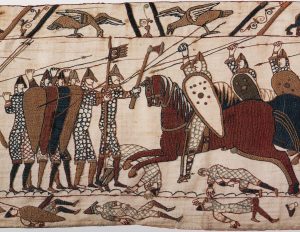
The barony held many nearby manors in Bedfordshire including Harlington, Clophill, Priestley (Flitwick), Maulden and Ampthill and Nigel almost certainly built and lived in Cainhoe Castle, a small motte and bailey castle to the south of Clophill, the remains of which can still be seen today.
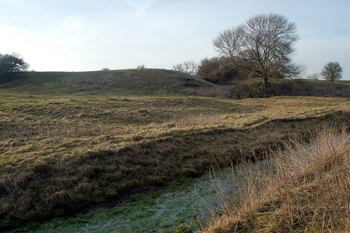
Cainhoe Castle March 2010
The whole barony was held from the king for the service of twenty five knights, to be provided to the royal army on demand. Nigel granted Tingrith Manor to a tenant named Turgis or Thorgils. The name Thorgils occurs a number of times in the Domesday Book for Bedfordshire; whether they are the same man is unknown. The other mentions are:
- “An Englishman” holding half a hide in Sharnbrook from the Bishop of Coutances;
- A man who had been a thegn of King Edward the Confessor and had held an estate in Eversholt before being deprived of it after the Conquest
- A man holding manors from Nigel de Albini in Husborne Crawley (five hides), “somewhere in the same Hundred” (one hide) and Priestley, part of Flitwick (1½ hides)
- A man holding three hides less one virgate from Nigel in Milton Ernest
It is tempting to see Thorgils as a thegn in Eversholt in 1066 who was deprived of his land but later managed to gain tenancies to greater lands in the neighbourhood (Tingrith, Flitwick, Husborne Crawley) and perhaps further afield (Sharnbrook and Milton Ernest).
The great survey commissioned by William the Conqueror at Christmas 1085, designed to show who held every piece of land in the newly conquered Kingdom of England, was known colloquially as the Domesday Book because it was seen as being as difficult to conceal things from, and as final as, the Last Judgement. The Domesday Book of 1086 is a manuscript written in medieval Latin with many abbreviations.

Tingrith was shown as having:
- 6 households (4 villagers and 2 smallholders);
- 3 ploughlands;
- 1 lord’s plough team;
- 2 men’s plough teams;
- 3 ploughs of meadow;
- Woodland for 150 pigs.
The number of households represents the heads of household, so to get an idea of the total population it is probably necessary to multiply this figure by a factor of at least four suggesting a total population of somewhere around 24. A plough is the taxable amount of land that can be ploughed by a team of eight oxen.
Tingrith was valued at 2 hides and 1 virgate. Typically land producing £1 of income a year was assessed at 1 hide and a virgate was one quarter of a hide, so in 1086 Tingrith was bringing in just over £2 per annum to the lord of the manor.In 1066 the value to the lord had been assessed at £5, but that had fallen to £1.50 by 1070. This was most probably the result of the advancing Norman army marching up the Icknield Way and seizing royal property belonging to King Harold, such as Westoning. As William’s army passed through the land they took animals, seed and food, and any resistance met with severe reprisals. Confiscation of plough oxen and seed corn would have been disastrous to the village for the following seasons.
The honour or barony of Cainhoe, including the manor of Tingrith, stayed with the d'Aubigny family until the death of Robert d’Aubigny in 1233 and the barony was divided between two of his daughters, Isabel and Azelina. Tingrith Manor may well have been split at this time.
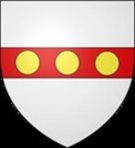
D'Aubigny coat of arms
By 1302, when the barony had been split even further, Isabel’s granddaughter Joan was shown as holding half a fee in Cainhoe, Clophill and Tingrith. (A fee represented the amount of land needed to support the provision of one knight to the King.) Joan married three times and she left a son by her second husband Sir Roger Dakeney, Robert, to whom her sixth share of the Cainhoe barony, including Tingrith, descended after her death in 1310.
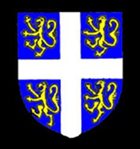
Dakeney coat of arms
Robert died in 1316 but by 1373 his son John Dakeney had managed to buy up the remaining shares of his great great grandmother Isabel’s half of the barony. Ironically, he died three years later and his son died as a minor in 1384, so his half of the barony passed out of the family, to John's sister Alice, wife of Walter Alnthorpe. Shortly after, between 1415 and 1428 this half of the barony was alienated to Reginald de Grey.
Meanwhile the other half of the Cainhoe Barony passed from Azelina and her husband Aimery de St Amand down through the St Amand family until 1441 when it was acquired by Sir John Cornwall, Lord Fanhope and Millbrook. After his death in 1443, most of John Cornwall’s Cainhoe lands were passed to different people depending on which king was currently winning the Wars of the Roses, but these lands eventually also passed to the de Grey family of Wrest Park, who now held both halves of the barony.
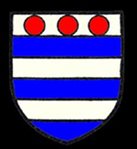
de Grey coat of arms
The de Grey’s presumably now held all the Manors of Tingrith as overlords, but it is possible that one manor escaped, Walwyn’s Manor.